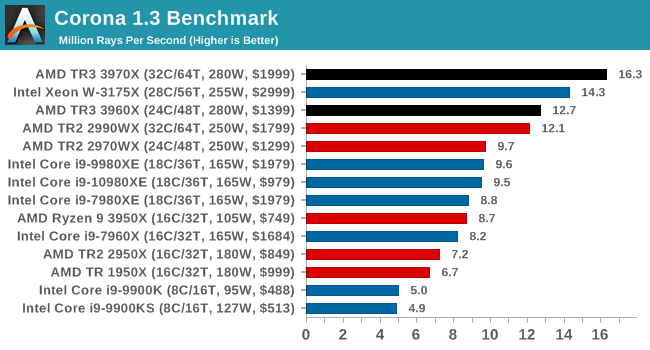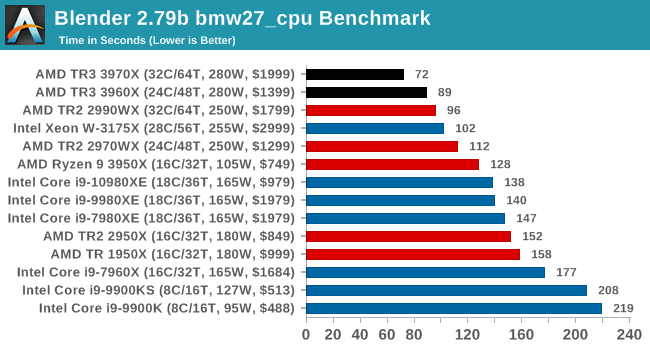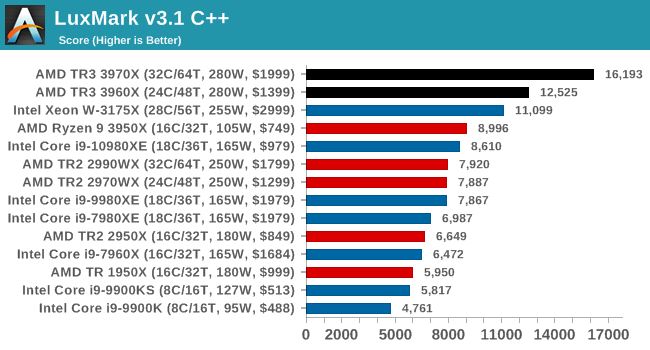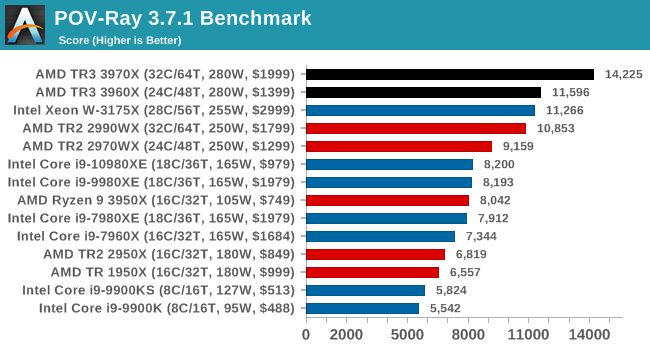The AMD Ryzen Threadripper 3960X and 3970X Review: 24 and 32 Cores on 7nm
by Dr. Ian Cutress, Andrei Frumusanu & Gavin Bonshor on November 25, 2019 9:05 AM ESTCPU Performance: Rendering Tests
Rendering is often a key target for processor workloads, lending itself to a professional environment. It comes in different formats as well, from 3D rendering through rasterization, such as games, or by ray tracing, and invokes the ability of the software to manage meshes, textures, collisions, aliasing, physics (in animations), and discarding unnecessary work. Most renderers offer CPU code paths, while a few use GPUs and select environments use FPGAs or dedicated ASICs. For big studios however, CPUs are still the hardware of choice.
All of our benchmark results can also be found in our benchmark engine, Bench.
Corona 1.3: Performance Render
An advanced performance based renderer for software such as 3ds Max and Cinema 4D, the Corona benchmark renders a generated scene as a standard under its 1.3 software version. Normally the GUI implementation of the benchmark shows the scene being built, and allows the user to upload the result as a ‘time to complete’.
We got in contact with the developer who gave us a command line version of the benchmark that does a direct output of results. Rather than reporting time, we report the average number of rays per second across six runs, as the performance scaling of a result per unit time is typically visually easier to understand.
The Corona benchmark website can be found at https://corona-renderer.com/benchmark

Being fully multithreaded, we see the order here follow core counts. That is except for the 32-core 2990WX sitting behind the 24-core 3960X, which goes to show how much extra performance is in the new TR generation.
Blender 2.79b: 3D Creation Suite
A high profile rendering tool, Blender is open-source allowing for massive amounts of configurability, and is used by a number of high-profile animation studios worldwide. The organization recently released a Blender benchmark package, a couple of weeks after we had narrowed our Blender test for our new suite, however their test can take over an hour. For our results, we run one of the sub-tests in that suite through the command line - a standard ‘bmw27’ scene in CPU only mode, and measure the time to complete the render.
Blender can be downloaded at https://www.blender.org/download/

We have new Threadripper records, with the 3970X almost getting to a minute to compute. Intel's nearest takes almost as long, but does only cost half as much. Again, the 3960X puts the 2990WX in its place.
LuxMark v3.1: LuxRender via Different Code Paths
As stated at the top, there are many different ways to process rendering data: CPU, GPU, Accelerator, and others. On top of that, there are many frameworks and APIs in which to program, depending on how the software will be used. LuxMark, a benchmark developed using the LuxRender engine, offers several different scenes and APIs.
In our test, we run the simple ‘Ball’ scene. This scene starts with a rough render and slowly improves the quality over two minutes, giving a final result in what is essentially an average ‘kilorays per second’.

Our LuxMark test again pushes both TR3 processors out in the lead.
POV-Ray 3.7.1: Ray Tracing
The Persistence of Vision ray tracing engine is another well-known benchmarking tool, which was in a state of relative hibernation until AMD released its Zen processors, to which suddenly both Intel and AMD were submitting code to the main branch of the open source project. For our test, we use the built-in benchmark for all-cores, called from the command line.
POV-Ray can be downloaded from http://www.povray.org/

More rendering, more wins for AMD. More losses for the 2990WX, even though on these tests it still beats the 10980XE quite easily.











245 Comments
View All Comments
lobz - Monday, November 25, 2019 - link
As well as the quality. Yes, dramatically.dscott1414 - Monday, November 25, 2019 - link
Totally awesome article. Could you correct the very last sentence?icoreaudience - Monday, November 25, 2019 - link
When will Anandtech display a modern compression algorithm within encoding tests ?Zstandard comes with a built-in benchmark compatible with multithreading, an ideal case to test threadripper !
Flying Aardvark - Monday, November 25, 2019 - link
Fully patched Intel microcode and Windows?yeeeeman - Monday, November 25, 2019 - link
Probably yes since 10980xe performance is lower than 9980xeblppt - Monday, November 25, 2019 - link
I'm hesitant to take any of these mega-core intel benchmarks as accurate, though--- the 7980/9980 Geekbench 4 scores are laughably low (9980 should be north of 50K, not 30K, at the very least), so there's definitely something wrong with AT's setup for these cpus.Maybe the other benches are correct, but GB4 at least is messed up.
fackamato - Monday, November 25, 2019 - link
Nope, mentioned in the article - BIOS update not available.So fully patched, the Intel results would be somewhat lower.
BrainWaveCC - Monday, November 25, 2019 - link
I see a couple of "Threadripper 3950X" references where I expected to see "Threadripper 3960X" instead. For instance:"The interesting question here of course is, how is this UMA domain setup for the Threadripper 3950X and 3970X?"
dcmsnd - Monday, November 25, 2019 - link
May i ask you guys how did you got 44s with 2990wx in Corona benchmark ? Im getting 41s with stock clocks (2933cl14 memory, Win1909, latest AMD drivers, latest bios)41 vs 44 is quite big difference in percentage for such small time frame.
41s vs 34s AND 44s vs 34s is also a lot of difference.
Dug - Monday, November 25, 2019 - link
I would like to know this too.